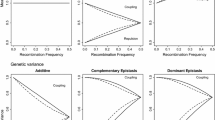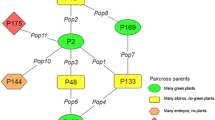Abstract
The interactive influence of winter and/or spring wheat genetic background on haploid induction parameters and trait correlation was studied by hybridizing five elite and diverse genotypes each of winter and spring wheat and their F1s (winter × winter, spring × spring, and winter × spring, generated in a diallel design excluding reciprocals) with a single genotype of maize. Data were recorded with respect to per cent seed formation, embryo formation, and regeneration. High genetic variability was present among the wheat genotypes (parents + F1s) for the three haploid induction parameters. Significant differences were obtained within and between different groups viz., spring wheats, winter wheats, spring × spring wheats, winter × winter wheats, and winter × spring wheats with respect to the three haploid induction parameters based on ANOVA. The winter genotypes (winter parents and winter × winter wheat hybrids) responded better than the spring groups (spring wheat parents, spring × spring and winter × spring wheat hybrids) with respect to embryo formation and winter × spring wheat hybrids yielded significantly the highest numbers of regenerants. Correlation studies amongst the haploid induction parameters indicated that the genes controlling seed formation and haploid plantlet regeneration are negatively correlated when the genetic backgrounds of both ecotypes are combined in winter × spring hybrids. Haploid embryo formation had no association with seed formation and regeneration in all genetic backgrounds, suggesting independent inheritance.
Similar content being viewed by others
References
Al-Jibouri, H.A., P.A. Miller & H.F. Robinson, 1958. Genotypic and environmental variances and covariances in an upland cotton cross of interspecific origin. Agron J 50: 633–636.
Amrani, N., A. Sarrafi & G. Alibert, 1993. Genetic variability for haploid production in crosses between tetraploid and hexaploid wheats with maize. Plant Breed 110: 123–128.
Bains, N.S., G.S. Mangat, K. Singh & G.S. Nanda, 1998. A simple technique for the identification of embryo carrying seeds from wheat × maize crosses prior to dissection. Plant Breed 117: 191–192.
Bitsch, C., S. Groger & T. Lelley, 1998. Effect of parental genotypes on haploid embryo and plantlet formation in wheat × maize crosses. Euphytica 103: 319–323.
Chaudhary, H.K., S. Singh & G.S. Sethi, 2002. Interactive influence of wheat and maize genotypes on the induction of haploids in winter × spring wheat hybrids. J Genet Breed 56: 259–266.
Grant, M.N. & H. Mckenzie, 1970. Heterosis in F1 hybrids between spring and winter wheats. Can J Plant Sci 50: 137–140.
Inagaki, M.N., 1985. Chromosome doubling of the wheat haploids obtained from crosses with Hordeum bulbosum L. Jpn J Breed 35: 193–195.
Inagaki, M.N. & M. Tahir, 1990. Comparison of haploid production frequencies in wheat varieties crossed with Hordeum bulbosum L. and maize. Jpn J Breed 40: 209–216.
Laurie, D.A. & S. Reymondie, 1991. High frequencies of fertilization and haploid seedling production in crosses between commercial hexaploid wheat varieties and maize. Plant Breed 106: 182–189.
Lefebvre, D. & P. Devaux, 1996. Doubled haploids of wheat from wheat × maize crosses: Genotypic influence, fertility and inheritance of the 1BL-1RS chromosome. Theor Appl Genet 93: 1267–1273.
Murashige, T. & F. Skoog, 1962. A revised medium for rapid growth and bio assays with tobacco tissue cultures. Physiol Plant 15: 473–497.
Pinthus, J.M., 1967. Evaluation of winter wheats as a source of high yield potential for the breeding of spring wheat. Euphytica 16: 231–251.
Sadasivaiah, R.S., B.R. Orshinsky & G.C. Kozub, 1999. Production of wheat haploids using anther culture and wheat × maize hybridization techniques. Cereal Res Commun 27: 33–40.
Suenaga, K., 1994. Doubled haploid system using the intergeneric crosses between wheat (Triticum aestivum) and maize (Zea mays). Bull Nat Inst Agrobiol Resour 9: 83–139.
Suenaga, K., & K. Nakajima, 1989. Efficient production of haploid wheat (Triticum aestivum) through crosses between Japanese wheat and maize (Zea mays). Plant Cell Rep 8: 263–266.
Tsuchiya, T., 1971. An improved acetocarmine squash method with special reference to the modified Rattembury's method of making a preparation permanent. Barley Genet Newsl 1: 71–72.
Verma, V., N.S. Bains, G.S. Mangat, G.S. Nanda, S.S. Gosal & K. Singh, 1999. Maize genotypes show striking differences for induction and regeneration of haploid wheat embryos in the wheat × maize system. Crop Sci 39: 1722–1727.
Author information
Authors and Affiliations
Corresponding author
Rights and permissions
About this article
Cite this article
Sharma, S., Sethi, G.S. & Chaudhary, H.K. Influence of winter and spring wheat genetic backgrounds on haploid induction parameters and trait correlations in the wheat × maize system. Euphytica 144, 199–205 (2005). https://doi.org/10.1007/s10681-005-5812-9
Received:
Accepted:
Issue Date:
DOI: https://doi.org/10.1007/s10681-005-5812-9




